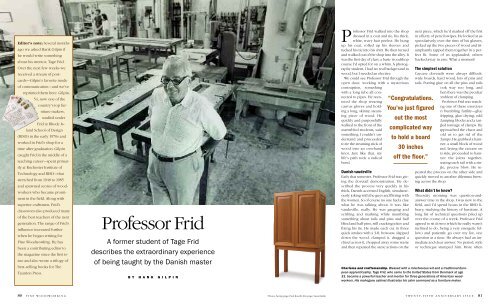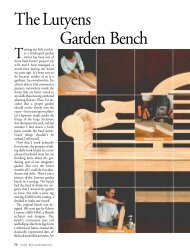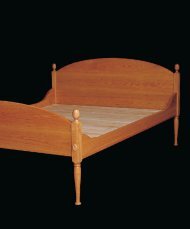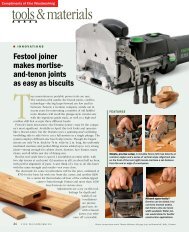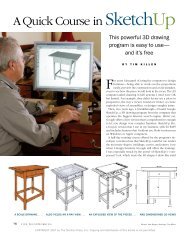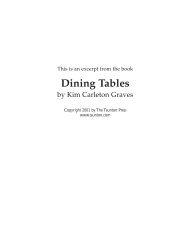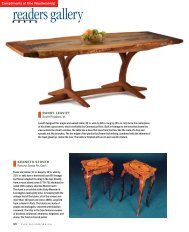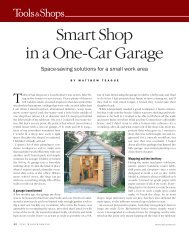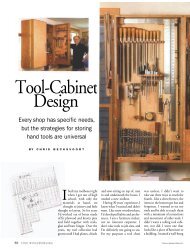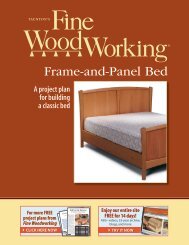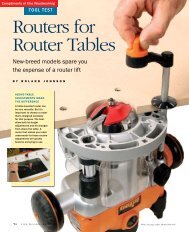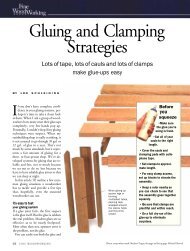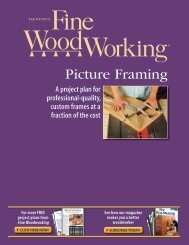Professor Frid - Fine Woodworking
Professor Frid - Fine Woodworking
Professor Frid - Fine Woodworking
- No tags were found...
Create successful ePaper yourself
Turn your PDF publications into a flip-book with our unique Google optimized e-Paper software.
Editor’s note: Several months<br />
ago we asked Hank Gilpin if<br />
he would write something<br />
about his mentor, Tage <strong>Frid</strong>.<br />
Over the next few weeks we<br />
received a stream of postcards—Gilpin’s<br />
favorite mode<br />
of communication—and we’ve<br />
reprinted them here. Gilpin,<br />
54, now one of the<br />
country’s top furniture<br />
makers,<br />
studied under<br />
<strong>Frid</strong> at Rhode Island<br />
School of Design<br />
(RISD) in the early 1970s and<br />
worked in <strong>Frid</strong>’s shop for a<br />
time after graduation. Gilpin<br />
caught <strong>Frid</strong> in the middle of a<br />
teaching career—spent primarily<br />
at Rochester Institute of<br />
Technology and RISD—that<br />
stretched from 1948 to 1985<br />
and spawned scores of woodworkers<br />
who became prominent<br />
in the field. Along with<br />
superior craftsmen, <strong>Frid</strong>’s<br />
classroom also produced many<br />
of the best teachers of the next<br />
generation. The range of <strong>Frid</strong>’s<br />
influence increased further<br />
when he began writing for<br />
<strong>Fine</strong> <strong>Woodworking</strong>. He has<br />
been a contributing editor to<br />
the magazine since the first issue<br />
and also wrote a trilogy of<br />
best-selling books for The<br />
Taunton Press.<br />
<strong>Professor</strong> <strong>Frid</strong><br />
A former student of Tage <strong>Frid</strong><br />
describes the extraordinary experience<br />
of being taught by the Danish master<br />
B Y H A N K G I L P I N<br />
<strong>Professor</strong> <strong>Frid</strong> walked into the shop<br />
dressed in a coat and tie, his thick,<br />
white, wavy hair perfect. He hung<br />
up his coat, rolled up his sleeves and<br />
tucked his tie into his shirt. He then turned<br />
and walked out of the shop into the alley. It<br />
was the first day of class, a basic woodshop<br />
course I’d opted for on a whim. A photography<br />
student, I had no real background in<br />
wood, but I needed an elective.<br />
We could see <strong>Professor</strong> <strong>Frid</strong> through the<br />
open door, working with a mysterious<br />
contraption, something<br />
with a long tube all connected<br />
to pipes. He reentered<br />
the shop wearing<br />
canvas gloves and holding<br />
a long, skinny, steaming<br />
piece of wood. He<br />
quickly and purposefully<br />
walked to the front of the<br />
assembled students, said<br />
something I couldn’t understand<br />
and proceeded<br />
to tie the steaming stick of<br />
wood into an overhand<br />
knot. Just like that, my<br />
life’s path took a radical<br />
bend.<br />
Danish vaudeville<br />
Early that semester, <strong>Professor</strong> <strong>Frid</strong> was giving<br />
the dovetail demonstration. He described<br />
the process very quickly in his<br />
thick, Danish-accented English, simultaneously<br />
joking with the guys and flirting with<br />
the women. So of course no one had a clue<br />
what he was talking about. It was like<br />
vaudeville, really. He was gauging and<br />
scribing and marking while mumbling<br />
something about tails and pins and half<br />
blind and half pins, still cracking jokes and<br />
fixing his tie. He made each cut in three<br />
quick strokes with a 3-ft. bowsaw, slapped<br />
down the wood, clamped it, dragged a<br />
chisel across it, chopped away some waste<br />
and then repeated the same actions on the<br />
“Congratulations.<br />
You’ve just figured<br />
out the most<br />
complicated way<br />
to hold a board<br />
30 inches<br />
off the floor.”<br />
next piece, which he’d marked off the first<br />
in a flurry of pencil swipes. He looked at us<br />
speculatively over the rims of his glasses,<br />
picked up the two pieces of wood and triumphantly<br />
tapped them together in a perfect<br />
fit. Some of us applauded; others<br />
backed away in awe. What a moment!<br />
The simplest solution<br />
Carcase dovetails were always difficult:<br />
wide boards, hard wood, lots of pins and<br />
tails. Putting glue on all the pins and tails<br />
took way too long, and<br />
then there was the peculiar<br />
problem of clamping.<br />
<strong>Professor</strong> <strong>Frid</strong> was watching<br />
one of these exercises<br />
in bumbling futility—glue<br />
dripping, glue drying, odd<br />
clamping blocks and a tangled<br />
tonnage of clamps. He<br />
approached the chaos and<br />
told us to get rid of the<br />
clamps. He grabbed a hammer,<br />
a small block of wood<br />
and, laying the carcase on<br />
its side, proceeded to hammer<br />
the joints together,<br />
seating each tail with a single,<br />
precise blow. He repeated<br />
the process on the other side and<br />
quickly moved to another dilemma brewing<br />
across the shop.<br />
What didn’t he know<br />
Thursday morning was question-andanswer<br />
time in the shop. I was new to the<br />
field, and I’d spend hours in the RISD library,<br />
studying the history of furniture. A<br />
long list of technical questions piled up<br />
over the course of a week. <strong>Professor</strong> <strong>Frid</strong><br />
agreed to sit down (which he really wasn’t<br />
inclined to do, being a very energetic fellow)<br />
and patiently go over my list, one<br />
question at a time. He always had an immediate<br />
and clear answer. No period, style<br />
or technique stumped him. More often<br />
Charisma and craftsmanship. Blessed with a mischievous wit and a traditional European<br />
apprenticeship, Tage <strong>Frid</strong>, who came to the United States from Denmark at age<br />
33, became a powerful teacher and mentor for three generations of American woodworkers.<br />
His mahogany cabinet illustrates his calm command as a furniture maker.<br />
80 FINE WOODWORKING<br />
Photos, facing page: Paul Roselli; this page: Susan Kahn<br />
T WENTY-FIFTH ANNIVERSARY ISSUE 81
“The best tool is the eye. Train the eye. The eye guides your hands<br />
to achieve the form. If the eye says it’s right, it is right.”<br />
A teacher’s report<br />
card: his students<br />
<strong>Frid</strong> pushed his students to achieve<br />
technical mastery of their medium<br />
but never insisted on stylistic unifor-<br />
than not he’d have two different technical<br />
solutions to offer: one of old tradition, focused<br />
on old tools and old technology, and<br />
the other emphasizing recent innovations<br />
in tools, machines, glues and finishes. He’d<br />
talk of animal glues and epoxy, chip carving<br />
and routers, hammer veneering and<br />
plastic laminate, French polish and spray<br />
lacquer, rasps and shapers. His knowledge<br />
seemed encyclopedic, felt experiential and<br />
was unbelievably valuable to me, a rank<br />
beginner who was falling under the spell<br />
of this amazing man.<br />
Ouch<br />
In <strong>Professor</strong> <strong>Frid</strong>’s class, crits—those peerand-teacher<br />
reviews that art students are<br />
subjected to—were always interesting but<br />
definitely intimidating. His criticism was<br />
sharp and only partly cushioned by his humorous<br />
comments and jovial banter. It was<br />
particularly nerve-racking to know that<br />
one of us would invariably be spotlighted<br />
for especially tough criticism.<br />
In his comments, sarcasm ruled: “Oh,<br />
Still tapping the<br />
source. Even long<br />
after graduation, a<br />
thorny technical<br />
problem—this one<br />
having to do with an<br />
extension table—<br />
could occasion a conference<br />
with the<br />
master. Here, in<br />
1981, <strong>Frid</strong> visits the<br />
author (left) in his<br />
shop. Between them<br />
is Chris Freed, who<br />
helped build the<br />
table.<br />
good curve. Too bad it’s the wrong one.”<br />
“Nice dovetails. What’d you use—a<br />
chainsaw”<br />
“Beautiful legs, Henry. What were you<br />
thinking about—an elephant”<br />
And the classic:<br />
“Congratulations. You’ve just figured out<br />
the most complicated way to hold a board<br />
30 inches off the floor.”<br />
Brutal.<br />
The mysterious pygmy chisels<br />
I’d taken a shine to <strong>Professor</strong> <strong>Frid</strong>’s shortbladed<br />
tang chisels. They were easy to<br />
hold and control, especially when cutting<br />
dovetails. I asked him where he’d acquired<br />
them. He gave me a quizzical look and<br />
said, “At the hardware store, where else” I<br />
couldn’t find them anywhere. Then it<br />
dawned on me. <strong>Professor</strong> <strong>Frid</strong> was no Zen<br />
tool guy. He’d use the closest tool on hand<br />
to do whatever needed to be done. His<br />
chisels found many uses: paint scraping,<br />
can opening, prying, wedging—often brutal,<br />
nick-inducing work. When he needed a<br />
sharp chisel, he’d simply run to the belt<br />
sander and, using the wheel portion of the<br />
machine, hollow-grind the nicks away.<br />
Then he’d grab a Belgium waterstone and<br />
quickly hone down the significant burr. In<br />
two minutes flat he had a razor-sharp—and<br />
a somewhat shorter—chisel.<br />
Play it by eye<br />
The table legs I was working on were a<br />
complex shape, simultaneously tapering<br />
and curving, dinghy-shaped in section. I’d<br />
purposely drawn this shape so I’d have to<br />
explore different tools to make them:<br />
spokeshaves, rasps and Surforms, maybe<br />
the unwieldy compass plane. I’d made a<br />
full-scale drawing with section views at<br />
various points in the leg to help me visualize<br />
the changing shape. I then made cardboard<br />
templates of each section view. I<br />
thought I’d use the templates while shaping.<br />
As I began whaling away, shaping the<br />
wood, I would periodically pick up a template<br />
to gauge my progress.<br />
Then <strong>Professor</strong> <strong>Frid</strong> spotted me from<br />
across the shop. He scurried over, grabbed<br />
the templates and tore them to pieces.<br />
Calmly, in very clear English, he told me,<br />
“The best tool is the eye. Train the eye. The<br />
eye guides your hands to achieve the form.<br />
If the eye says it’s right, it is right.”<br />
I died when I saw those templates go, but<br />
that moment changed the way I work for<br />
good. Every day I’m in the shop I benefit<br />
from the freedom it gave me.<br />
“Get it otta heeah”<br />
Every piece I built in school was designed<br />
to explore a new and difficult technical<br />
problem. One desk I built was conceived<br />
to delve into curvilinear form, heavy shaping<br />
and tambours. It was quite derivative,<br />
based on a piece I’d seen in a California<br />
craft magazine and was by no means traditional,<br />
but it was fairly functional and<br />
somewhat interesting.<br />
I worked around the clock to complete<br />
the desk while <strong>Professor</strong> <strong>Frid</strong> was away on<br />
vacation over winter session. I finished just<br />
in time and was very pleased with the re-<br />
mity. His goal was simply to provide<br />
a solid foundation that would enable<br />
students to succeed. <strong>Frid</strong> felt compelled<br />
to pass on what he knew, and<br />
that was contagious. The photos on<br />
the next three pages show work by a<br />
half dozen of his former students.<br />
Five of the six have been influential<br />
teachers themselves, and the other<br />
has trained a string of apprentices.<br />
sults. When he walked in, all tanned and<br />
relaxed, he looked at one student’s project,<br />
said hello to another student and then<br />
turned to look at my desk.<br />
He gave it a cursory glance, turned to<br />
one of the other students and asked, “Who<br />
made this piece of crap Get it otta heeah.”<br />
He chuckled, turned to me and added,<br />
“Nice job, Henry, now go design something<br />
good.”<br />
Brrrr<br />
We were a graduate class of three that year:<br />
Roger, Alphonse and me. When <strong>Professor</strong><br />
<strong>Frid</strong> arrived in the morning, Roger and I<br />
would be sitting at our benches, drinking<br />
coffee and shooting the breeze. Alphonse<br />
would join us if he hadn’t been working<br />
until dawn. <strong>Professor</strong> <strong>Frid</strong> would look at<br />
us, look at his watch, scan the quiet shop<br />
and ask us if we were having a good time.<br />
Then he’d say something like: “Come on,<br />
boys, it’s time to work! The day is passing<br />
and what are you accomplishing Go! Go!<br />
Go! Your work won’t make itself!”<br />
He’d crack a few jokes while prodding us<br />
to work, suggesting, with his inimitable<br />
sarcasm, that perhaps we could find other<br />
times to waste on idle chatter. And always,<br />
as he walked away, he’d point out the window<br />
toward the city street beyond and say,<br />
“It’s cold out there, boys!”<br />
It was his mantra, repeated over and<br />
HANK GILPIN, LINCOLN, R.I. (RISD, 1970-1973); WHITE OAK SIDEBOARD, 1995<br />
Of his former teacher, Gilpin said, “He didn’t educate people in order to reproduce himself<br />
or justify himself but to pull things out of them … he was attracted to the power of<br />
potential in a student; he didn’t want to crush it. He wouldn’t tell a student ‘Here’s what<br />
you are.’ Instead, he said, ‘Here’s what’s possible’”<br />
over: “It’s cold out there. ... It’s cold out<br />
there.”<br />
Brrrr ... How true!<br />
Under the eye of the clock<br />
After my classmate Alphonse and I graduated<br />
from RISD, Mr. <strong>Frid</strong> hired us to work<br />
in his shop. And work it was: hard, fast, direct.<br />
We went right to work at seven and<br />
quit at precisely 3:30. A much-loved coffee<br />
break of 20 minutes and a quick lunch fuelup<br />
at 12:30 were the only breaks. Each<br />
day’s work was planned the previous day<br />
with specific tasks assigned to each of us.<br />
Mr. <strong>Frid</strong> acted as manager and foreman.<br />
He delegated tasks to suit our abilities<br />
while always pushing us to higher levels of<br />
craftsmanship and responsibility. He discouraged<br />
conversation and questions not<br />
pertinent to the task at hand. Any interruption<br />
to his concentration received a strong<br />
rebuke. Loss of focus led to mistakes, and<br />
JERE OSGOOD, WILTON, N.H. (RIT, 1957-<br />
1960); WALNUT SIDE CHAIR, 1992<br />
Distinguished as a designer and as a<br />
teacher, Osgood taught at RIT from<br />
1971 to 1974 and at Boston University’s<br />
Program in Artisanry from 1975 to<br />
1985. Osgood said that in the classroom,<br />
“<strong>Frid</strong> was a precipitator, a<br />
catalyst—he got the best things out of<br />
people. His presence was very strong.<br />
He had an energy and a complete devotion<br />
to the field I hadn’t seen before.”<br />
82 FINE WOODWORKING Photos, this page: courtesy of Hank Gilpin<br />
Photos, this page: Jonathan Binzen (top); Dean Powell (bottom)<br />
T WENTY-FIFTH ANNIVERSARY ISSUE 83
Tage <strong>Frid</strong>’s concern as a teacher<br />
focused on the singular potential in each individual he taught.<br />
JOHN DUNNIGAN, WEST KINGSTON, R.I. (RISD, 1977-1980); LEATHER ARMCHAIRS, 1988<br />
Dunnigan, who has taught at RISD for 20 years while maintaining his own shop, said, “Tage’s influence<br />
was often more technical than conceptual. He gave you an honest, practical answer, and you<br />
believed it. And I learned a lot about life from him as well as about making furniture.” After studying<br />
under <strong>Frid</strong>, Dunnigan served as his teaching assistant and went on to help him with the writing of<br />
the second and third books of the trilogy Tage <strong>Frid</strong> Teaches <strong>Woodworking</strong> (The Taunton Press).<br />
mistakes meant loss of profit—not an acceptable<br />
consequence in Mr. <strong>Frid</strong>’s mind.<br />
The jovial banter was far less evident here<br />
than it had been before in the classroom.<br />
At the stroke of half past three, he put<br />
down his tools and sent us home. He’d<br />
worked eight hard hours to earn his keep,<br />
and the remainder of the day was his to<br />
plant and tend the garden or care for his<br />
menagerie of farm animals. He felt a person<br />
should have interests outside their<br />
work or the mind would go stale and then<br />
the work would suffer.<br />
What’s the problem<br />
The banker, the contractor and Mr. <strong>Frid</strong><br />
stood in the richly paneled English oak<br />
boardroom at the turn-of-the-century<br />
bank. The bank was moving, and the<br />
banker wanted the old boardroom moved<br />
to the new tower. The contractor said it<br />
couldn’t be done. <strong>Frid</strong>, consulting for both,<br />
said, “What’s the problem Of course it can<br />
be done!” The following week, under Mr.<br />
<strong>Frid</strong>’s supervision, Alphonse and I Skilsawed<br />
the boardroom apart. Three months<br />
later, after a bonanza of stripping, repairing,<br />
reconfiguring and refinishing, the new<br />
tower got its old boardroom.<br />
Whipping up a window<br />
We were putting a small addition on his<br />
house. The job was going well, as his jobs<br />
nearly always did: clean and quick, well organized.<br />
We would finish ahead of schedule.<br />
Near the end of the workday, Mr. <strong>Frid</strong>’s<br />
wife, Emma, surveyed the situation and<br />
firmly but gently made it clear that another<br />
window was necessary. Mr. <strong>Frid</strong> made it<br />
equally clear that he didn’t feel the need.<br />
Emma simply pointed to the spot she had<br />
in mind for it and returned to her kitchen.<br />
Mr. <strong>Frid</strong> put down his hammer, made a few<br />
measurements and went off to his shop,<br />
muttering to himself in Danish. I finished<br />
framing a door and discreetly left for the<br />
day. I returned the next morning at seven.<br />
Five minutes later Mr. <strong>Frid</strong> sauntered down<br />
from his shop with a freshly made window,<br />
glazed and with casing. We put it in. Emma<br />
came back, glanced approvingly, smiled,<br />
thanked us and returned to her chores.<br />
Glue and pray<br />
The glue-up was complex and somewhat<br />
vexing—too many parts, too many angles<br />
and way too many clamps. We almost had<br />
it together. Maybe just one more clamp ...<br />
just a little more pressure ... BOOM! The entire<br />
assembly exploded. Clamps crashed to<br />
the floor, and the piece slumped and then<br />
splintered. Six weeks of work destroyed.<br />
We were distraught. Mr. <strong>Frid</strong> walked in,<br />
eyed the situation, grabbed a glue bottle,<br />
splashed glue on the myriad bits and pieces<br />
and told us to put it back together—quickly!<br />
We did. It worked. The piece, a circulation<br />
desk for the RISD library, is still in use today,<br />
30 years later. And only we are the wiser.<br />
An appetite for fine work<br />
The phone rang in Mr. <strong>Frid</strong>’s shop around<br />
nine one morning. We were finishing some<br />
very elegant doors for a ship restoration.<br />
Merlin Szoz was applying gold leaf, I was<br />
repairing inlay and Mr. <strong>Frid</strong> (he was Mr.<br />
<strong>Frid</strong> for quite some time to me!) was<br />
French-polishing. He took the call, conversed<br />
briefly in Danish and skedaddled<br />
out the door toward the house. Merlin and<br />
I continued to work. Mr. <strong>Frid</strong> returned (we<br />
could hear the door but not see it), and the<br />
bandsaw started up. The sound of the cutting<br />
was unusual. Ummmmmzeeepummm<br />
... ummzeeepummm ... ummzeepumm.<br />
What the heck I had to take a peek. I<br />
took a few paces to look around the corner,<br />
and there was Mr. <strong>Frid</strong> with a frozen<br />
pork loin, sawing it into chops. He gave me<br />
a quick look, winked, patted his stomach<br />
and went back to work.<br />
One more crit<br />
A few years ago I had an open house at my<br />
shop. I invited Mr. <strong>Frid</strong>, but I didn’t think he<br />
would come. He was retired and, I thought,<br />
perhaps not that interested in what his<br />
long-ago students might be up to. But he<br />
did come, and I must admit I was very<br />
pleased. And I felt a little tingle of nerves.<br />
He walked around the shop for about 45<br />
minutes, checking out the pieces on display.<br />
I watched him but was unable to read<br />
his reactions. Finally, he walked over to me<br />
and said, “So, Henry, this is a good collection<br />
of work. And I see you had a very good<br />
teacher. But tell me, who is your designer”<br />
Always the jokester.<br />
A teacher’s gift<br />
Mr. <strong>Frid</strong> would be the last to accept the notion<br />
of genius in his life’s work, but there it<br />
was in the improbable combination of supercharged<br />
ego and passionate concern<br />
for his students. The ego fueled his fiery<br />
confidence and self assurance. The concern<br />
focused on the singular potential in<br />
each individual he taught. Instead of imposing<br />
his own very strong aesthetic on<br />
students, he demanded that they develop<br />
technical breadth and expertise, and simultaneously<br />
he coerced and cajoled students<br />
to seek a finer articulation of their personal<br />
creative passions. Jere Osgood, Bill<br />
Keyser, Alphonse Mattia, John Dunnigan,<br />
Rosanne Somerson ... each of these and<br />
scores of other former <strong>Frid</strong> students are<br />
successful furniture makers recognized for<br />
their personal vision and fine craftsmanship.<br />
Though a whisper of his ideas might<br />
linger in their designs, his real legacy is that<br />
he didn’t want or need these or any of his<br />
other students to emulate his work, but<br />
rather he wanted them to stand apart, with<br />
the hope that the skills he taught them<br />
would ensure success in their pursuits. <br />
Hank Gilpin designs and builds furniture in<br />
Lincoln, R.I.<br />
ROSANNE SOMERSON, WESTPORT, MASS.<br />
(RISD, 1972-1976); CHESTNUT OAK AND<br />
BLEACHED LACEWOOD CABINET, 1995<br />
“Tage gained everyone’s respect with his sense<br />
of humor,” Somerson said. “He was charismatic,<br />
encouraging, slightly devilish yet fatherly.” <strong>Frid</strong><br />
hired Somerson to replace him when he retired<br />
from RISD in 1985, and she is now head of the<br />
furniture department there. Somerson was an<br />
early editor at <strong>Fine</strong> <strong>Woodworking</strong> and helped<br />
<strong>Frid</strong> with his first book.<br />
ALPHONSE MATTIA, WESTPORT, MASS.<br />
(RISD, 1971-1973); LACEWOOD AND<br />
MAHOGANY BED, 1995<br />
“Tage had a joie de vivre that came<br />
through in everything he did. For me it<br />
wasn’t his aesthetic so much as his life<br />
as an artist that was so exciting and inspiring.”<br />
Mattia, who taught at Boston University’s Program<br />
in Artisanry for 11 years, has been teaching at RISD<br />
since 1992.<br />
84 FINE WOODWORKING Photo, this page: Ric Murray<br />
Photos, this page: Dean Powell; drawing Alphonse Mattia<br />
T WENTY-FIFTH ANNIVERSARY ISSUE 85


